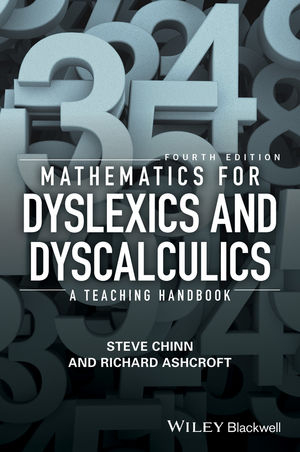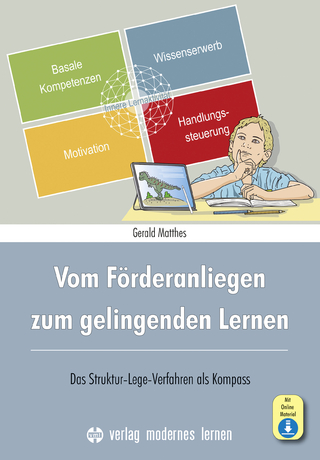
Mathematics for Dyslexics and Dyscalculics
Wiley-Blackwell (Verlag)
978-1-119-15996-4 (ISBN)
Provides a complete overview of theory and research in the fields of dyslexia and dyscalculia, along with detailed yet pragmatic methods to apply in the classroom
Contains enhanced coverage of place value and the role of the decimal point, why fractions can challenge a developed logic for arithmetic, and the complexity of time along with new material on addressing anxiety, fear, motivation, and resilience in the classroom; and links to new resources including standardized tests and recommended reading lists
Written by two mathematics teachers with 50 years of teaching experience between them, much of it in specialist settings for students with specific learning difficulties
Offers effective teaching strategies for learners of all ages in a structured but accessible format
STEVE CHINN is an independent lecturer, writer and researcher, and Visiting Professor at the University of Derby, UK. He spent 24 years as headteacher of three specialist schools and was a mainstream teacher for 14 years. He was Founder and Principal of Mark College in Somerset, UK, a specialist residential school for young people with specific learning difficulties. In 2011 he set up and chaired the BDA's first subcommittee on dyscalculia. He has received the Marion Welchman International Award for Services to Dyslexia, and the Lady Radnor Award for Lifetime Services to Dyslexia. He has lectured and taught in over 30 countries worldwide and is the author of numerous books. RICHARD ASHCROFT was headmaster at Mark College, UK, a specialist residential school for young people with specific learning difficulties. He taught mathematics at the secondary school level for almost 25 years. During his teaching career, he developed a series of teaching resources specifically for dyslexic students. He retired in 2006.
Foreword xi
1 Dyscalculia, Dyslexia and Mathematics 1
Introduction 1
Definitions of Dyslexia 3
The Evolution of Definitions of (Developmental) Dyscalculia 5
The Nature of Mathematics and the Ways it is Taught 19
2 Factors that may Contribute to Learning Difficulties in Mathematics 23
Potential Areas of Difficulty in Learning Mathematics 24
General Principles of Intervention 44
Summary 46
3 Cognitive (Thinking) Style in Mathematics 48
Introduction 48
Qualitative and Quantitative Style 49
Cognitive (Thinking) Style in the Classroom 51
Examples 54
Summary 61
4 Testing and Diagnosis 62
A Diagnostic Test Protocol 64
Structure of the Diagnostic Protocol 65
Attitude and Anxiety 73
Thinking Style or Cognitive Style 74
Tests for Dyscalculia 74
Summary of the Test Protocol 74
5 Concept of Number 76
Introduction 76
Early Recognition of Numbers and Their Values 78
The Language of Mathematics (see also Chapter 2) 79
Early Number Work 79
Visual Sense of Number 82
Visual Clues to Number Concept 83
Number Bonds/Combinations 84
Place Value 86
Number Bonds/Combinations for Ten 93
Numbers Near Ten, Hundred or Thousand 94
Summary 95
6 Addition and Subtraction: Basic Facts/Number Combinations 96
Introduction 96
Strategies for Learning/Remembering the Addition and Subtraction Facts 99
Overview 107
Subtraction Facts 108
Extension 109
7 The Times Tables Facts/Number Combinations 110
Introduction 110
Rote Learning Strategies 110
Learning by Understanding 113
The Commutative Property 115
Learning the Table Square 117
Summary 135
8 Computational Procedures for Addition and Subtraction 136
Estimation 138
Addition 138
Teaching Subtraction as a Separate Exercise 147
9 Multiplication 152
Introduction 152
Multiplying by Ten and Powers of Ten 153
Multiplication 157
Estimation 163
Extension 163
10 Division: Whole Numbers 165
Introduction 165
Introduction to Division 166
Estimating 172
Division by Powers of Ten 173
Division by Multiples of Powers of Ten 174
Conclusion 174
11 Fractions, Decimals and Percentages: An Introduction 175
Introduction 175
Fractions 176
Decimals 187
Percentages 195
Overview 203
12 Operating with Fractions 204
Introduction 204
Making Segment Sizes the Same 205
Comparing Fractions 207
Combining Fractions 210
Adding Fractions 212
Subtracting Fractions 216
Combined Additions and Subtractions 219
Multiplying by Fractions 221
Multiplying Mixed Fractions 224
Dividing with Fractions 227
13 Decimals 232
Introduction 232
Addition and Subtraction 232
Multiplication and Division by Powers of Ten 235
Division of Decimals 242
Summary 249
14 Percentages 250
Introduction 250
An Image of Percentage 250
Summary 256
15 Time 257
What are the Potential Problems with Time? 258
Reading the Time 260
Time Problems 264
Summary 268
16 Teaching the Full Curriculum 269
Introduction 269
Some General Principles 270
Teaching the Other Parts of the Curriculum 277
Combining the Parts of the Curriculum 282
Summary 286
17 Attacking and Checking Questions 287
Practice Examples 287
Preliminary Checks 288
Attacking Questions 290
Methods of Attacking Questions 291
Checking 298
18 Important Elements of a Teaching Programme 303
Introduction 303
Consider the Pupils’ Needs 303
The Structure of the Course 304
Classroom Management: Making the Lessons Suit the Pupils 308
Evolving Expectations and Emphases 309
Internal Assessment 313
Summary 315
Appendices
Appendix 1: Books, Journals, Tests and Games 316
Appendix 2: Teaching Materials 321
References 324
Index 337
| Erscheinungsdatum | 14.01.2017 |
|---|---|
| Verlagsort | Hoboken |
| Sprache | englisch |
| Maße | 152 x 226 mm |
| Gewicht | 476 g |
| Themenwelt | Schulbuch / Wörterbuch |
| Geisteswissenschaften ► Psychologie | |
| Sozialwissenschaften ► Pädagogik ► Sonder-, Heil- und Förderpädagogik | |
| ISBN-10 | 1-119-15996-2 / 1119159962 |
| ISBN-13 | 978-1-119-15996-4 / 9781119159964 |
| Zustand | Neuware |
| Haben Sie eine Frage zum Produkt? |
aus dem Bereich


